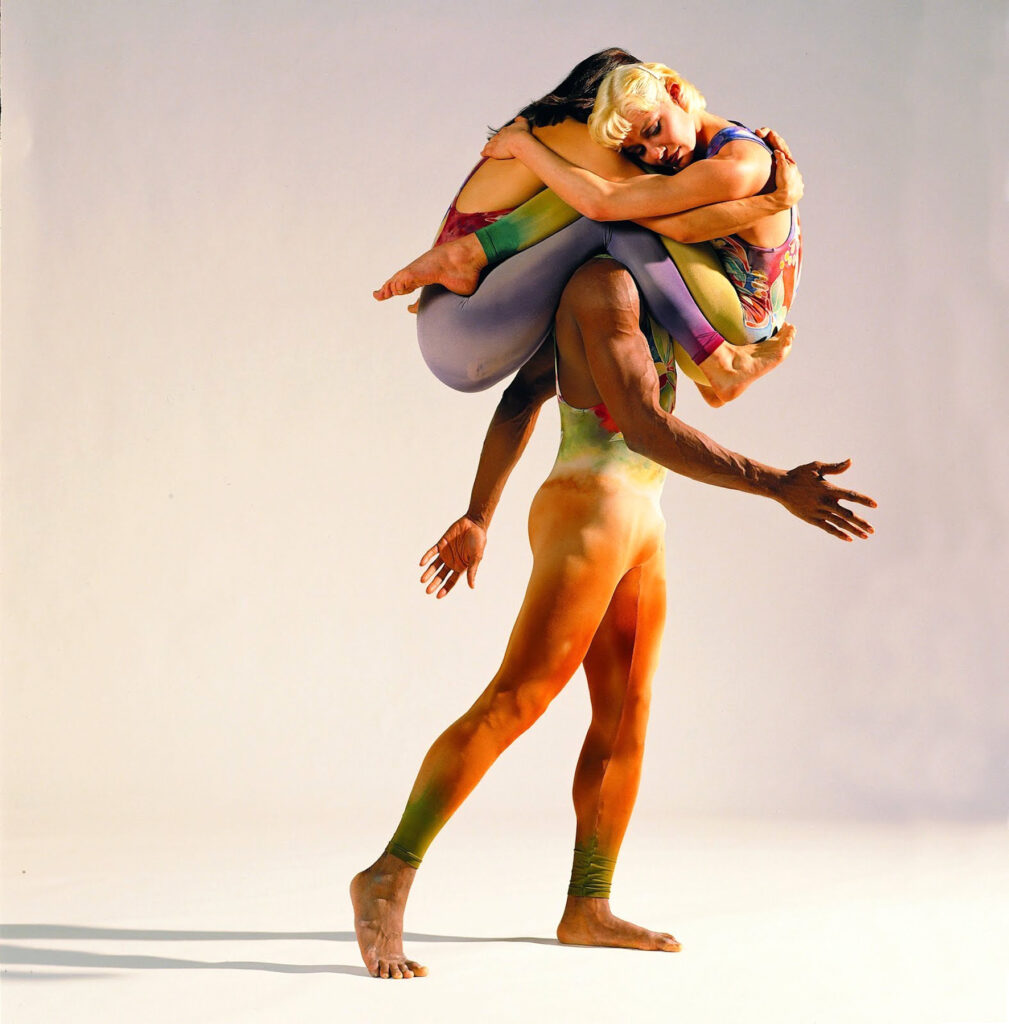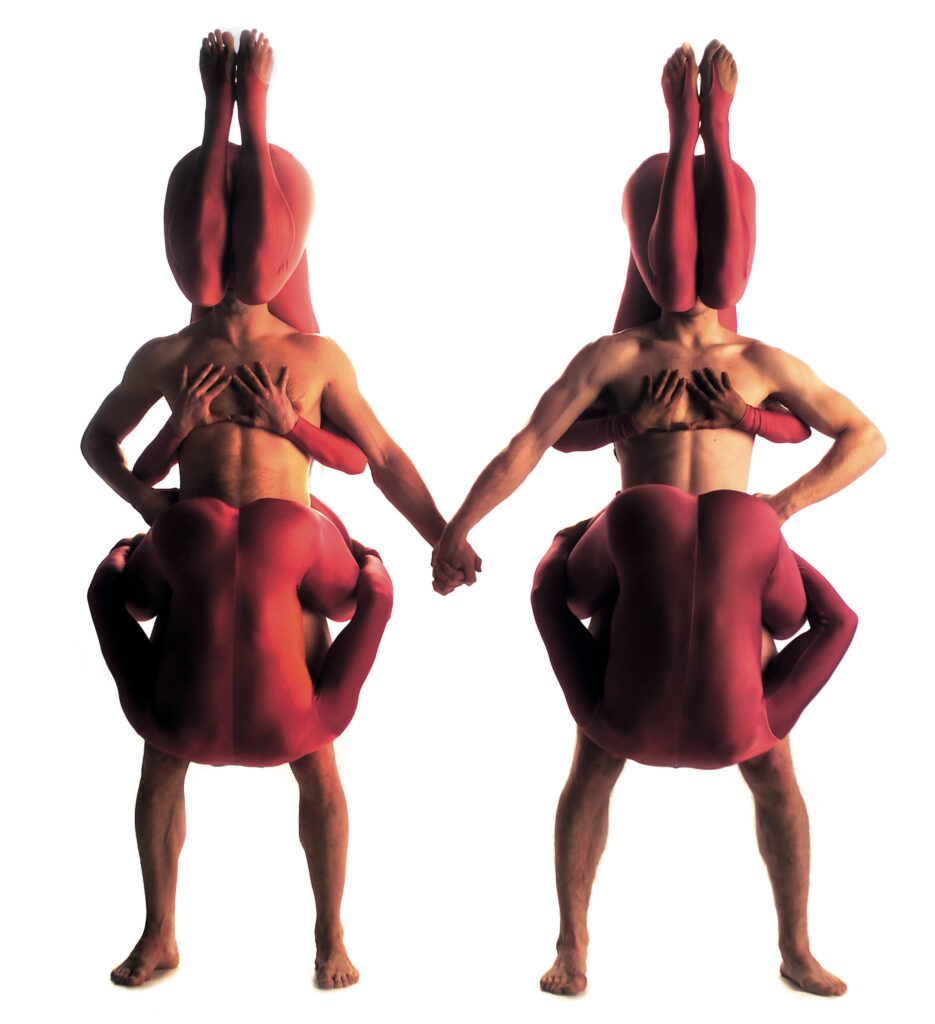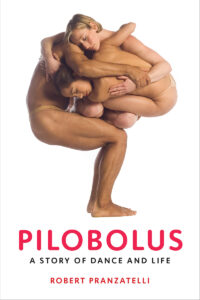They were called Pilobolus Dance Theatre, or simply Pilobolus. On the mid-1990s night that I first saw them—one of the best nights I’d ever had in a theater—the company was in its twenty-fifth season and already long praised for its wit, style, sensuality, and innovative approach to human physicality.
It had originated as an all-male trio in a Dartmouth dance class in 1971 and soon expanded to an all-male quartet and then to a sextet that included two women. It was this last configuration that achieved fame in the 1970s, with a Broadway run. The New Yorker’s Arlene Croce had declared Pilobolus not a dance company but a “brilliant acrobatic-mime troupe” that consisted of, in her view, “six of the most extraordinary people now performing.” A couple of decades later, and after much further evolution, Pilobolus was still thriving.
Eager to learn more, I made use of a relatively new resource called the internet. The troupe itself didn’t seem to have done much with it yet, but a man who had found Pilobolus as revelatory as I had—and whose name and writings I can no longer locate—had posted an essay entitled “The First Time I Saw Pilobolus.”
In his case the inspiration had much to do with the occasional nudity and frequent near-nudity of the male dancers, not in a prurient sense (though, as a gay man, he was certainly attracted to their handsome, ideal physiques) but because seeing these men interact in a nonsexual but intimate way, without much clothing and with neither shame nor homophobia, was for him profoundly affirming and liberating. His essay articulated an important aspect of the performance I’d seen.
Spiral. Copyright © John Kane / Silver Sun Studio. All rights reserved. Used by permission.
I remained interested in Pilobolus, and several years later, in May 2002, I saw them at a Saturday matinee in New Haven. The selection of pieces was different and so were most of the dancers, except for that guy again: Matt Kent, still full of energy, still remarkable, and now listed in the program as “dance captain.” I imagined he must have moved up in status—even though, in the only piece that I recognized from a few years earlier, the slapstick Walklyndon, he was still being stepped on by everyone else.
Afterward, in another round of online searching, I discovered that Pilobolus had begun publishing an annual wall calendar. It contained no performance shots; instead, many of the set-ups used a simple white background with the dancers in brightly colored leotards or a minimum of clothing (dance belts, for an essentially nude look), with nothing to distract from the playfulness and sheer physical beauty of their inventive poses (two dancers partnering, with one partner upside-down; several dancers combined to form a larger creature; two dancers demonstrating a seemingly impossible, or highly improbable, lift; and so on). As the years rolled along, the calendars kept the Pilobolus energy subtly pulsing in the background of my life.
More than a decade after I had first seen them perform, I learned of a weeklong Pilobolus summer workshop, open to nondancers as well as dancers, taught in their studio in western Connecticut. It sounded exhilarating and, to me, terrifying. But I saw that it would be taught by the husband and wife team of Matt and Emily Kent. Yes, that Matt.
*
On Monday, July 14, 2008, the first morning of the workshop, a Pilobolus staff member greeted each of the two dozen or so participants, many of them twenty years younger than myself and most of them female, as we arrived, and checked off our names. I milled around, as did others, discreetly checking out the surroundings—the spacious Washington Club Hall with its hardwood floors and barn-high ceiling—and, more discreetly, checking out my instructors.
Matt, in a t-shirt and sweatpants, his hair now short, sat on the floor hunched over an Apple laptop like a mad scientist oblivious to the room around him. Emily stood calmly nearby with an infant in her arms, and occasionally spoke with the few people in the room who already knew her. I had never seen her before.
In her early thirties, with long brown hair, and, like her husband, wearing a t-shirt and sweatpants, and in fantastic shape, what struck me most was her face, not simply because it was pretty but because she bore a kind of family resemblance to a girl with whom I had once been hopelessly in love, while also a close friend and confidant, in my teens. I suddenly had the secret thought that Matt had excellent taste. I also sensed that he and Emily were a simpatico pair, an intuition that grew more certain when we all sat on the floor and circled up to introduce ourselves.
 Walking Creature. Copyright © John Kane / Silver Sun Studio. All rights reserved. Used by permission.
Walking Creature. Copyright © John Kane / Silver Sun Studio. All rights reserved. Used by permission.
Each of us in turn was to state our name, where we lived, our profession, and what we expected from the workshop. About halfway around the circle, one young woman stated only the first three items, and was asked: “And your expectations?”
“Oh, zero,” she said, a bit emphatically, to assert that she had arrived with an open mind. “I have zero expectations.”
“We can meet those expectations,” Emily said with playful assurance.
The line got a laugh. She had delivered it exactly the way certain of my dearest friends from my college days would have, with a slight emphasis on the word meet.
I like her, I thought, and suddenly felt that she and Matt might be of my tribe.
The entire group, even at this early moment, seemed to connect, and it felt as if I were rejoining a group I’d been in before, reconvening. After a few words about the coming week, Emily asked us to stand and then told us to “start walking”—all of us, in any direction, or all directions, as she and Matt called out instructions. They told us to use different speeds (slower, faster), to go through the middle of the space as well as around the outer edges, to avoid touching, to brush against each other or bump lightly, to make eye contact or not, and to try other, different kinds of movement—to learn to be aware of oneself, others nearby, then the group as a whole and one’s own choices within the larger group’s evolving choices from moment to moment.
With everyone gradually picking up on the same gesture or behavior and then letting it transform, by the end of this ever-morphing exercise we were dancing en masse, a group already bonded and unified. Again I had the sense of being right where I belonged, having reconvened with old friends or old souls.
The entire group, even at this early moment, seemed to connect, and it felt as if I were rejoining a group I’d been in before.
Throughout the morning we did other exercises that also evolved into improvisations, and as the day proceeded we improvised without music and with music added. We created short pieces in groups of four, with no soundtrack, then Matt would select from his iTunes and throw the music on and we would have to adapt to it as we performed.
At one point he used a terrific jazz track that I identified, with amazement, as a jazz remake of Nirvana’s “Smells Like Teen Spirit.” When asked, Matt told us the name of the band, but by the end of the day I had forgotten it. Before leaving I walked up to him and asked again. “The Bad Plus,” he said, and mentioned that they had also recorded a version of “Heart of Glass.”
“Ah, now you’ve said the magic words,” I replied, and told him of my longtime Blondie obsession. As we spoke briefly about cover versions, I saw that on the subject of music Matt glowed; and a little while later, alone in my room at the inn where I was staying, I realized that there had been a moment when his face had taken on a familiar look—but how could that be possible, given that we had never met before? I struggled to place it, and finally realized that it was the look my friend John Kulka gets when he’s pleased with something I’ve said—a certain friendship-related satisfaction—a detail I found intriguing, particularly as Matt and John don’t really resemble each other.
I had approached the workshop with some trepidation, despite my enthusiasm. A lifelong nonathlete as well as a nondancer, I tended to associate physical challenges with failure, misery, and ridicule. What I had seen of Matt suggested he was a nice guy, but how did I know what he’d be like as an instructor? A few months prior to the workshop I had watched a documentary film about Pilobolus entitled Last Dance, which I had loved, but it revealed some of the tensions and arguments between artistic directors. Matt, one of the dancers, wasn’t directly involved in the arguments but was described, in the film and one of the accompanying short features on the DVD, as “crazy” and “intense.” These adjectives seemed meant in a mostly positive way, but again, how was I to know?
 Position to Celebrate. Copyright © John Kane / Silver Sun Studio. All rights reserved. Used by permission.
Position to Celebrate. Copyright © John Kane / Silver Sun Studio. All rights reserved. Used by permission.
I had become aware of his formidable resumé in an online bio note (sample sentence: “He has performed on stilts, on trapeze, on circus silks, and of course on other dancers”). Now, on the first day of the workshop, I had begun to see that the intensity of his husky voice, large biceps, and overall demeanor had its match in the quickness of his perceptions and the fast pace and high energy that animated him, but what seemed most unusual was his focus.
Often an extraordinarily energetic person has a slightly out-of-control quality, and the perpetual motion can be exhausting to be around, yet Matt’s boundless energy seemed to have its own built-in discipline, as if he knew exactly how to channel it. That martial arts had played a role in his life helped to explain this, but I’d never met anyone like him. Instead of finding his intensity draining or intimidating, I found I got energy from being around him, a gift of vitality.
By the second day I began to realize that the trappings of the workshop, the surrounding details—doing yoga in my room at the Heritage Inn; my related morning rituals; my tote bag with towel, bottled water, granola bars, and one or two other useful items; my daily arrival, entering Club Hall each morning and stretching, and doing more yoga on the hardwood floor (we used no mats, a choice that surprised me but to which I soon grew attached); my return, for the first time in decades, to the habit of going barefoot for hours at a time; lunches in the pleasantly shady little café across the way—were also a vital part of the experience, and made me feel as if this were not only a workshop but a life.
__________________________________

Excerpted from Pilobolus: A Story of Dance and Life by Robert Pranzatelli. Published by University Press of Florida in April 2024. Used by permission.

